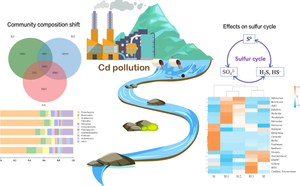Biogeochemistry ( IF 3.9 ) Pub Date : 2024-07-13 , DOI: 10.1007/s10533-024-01150-2 Min Wang , Yuannan Wang , Yanli Wu , Qianli Ma , Jilin Huang , Tao He , Shan Huang , Chen Chen

|
The large leakage accidents of heavy metals from industrial facilities pose a serious environmental problem; however, not enough studies have been conducted to assess the long-term ecological risk associated with such accidents. This study evaluated changes in the bacterial communities within river sediment and identified the key functional microorganisms responding to the 2012 cadmium contamination incident in the Long River, Guangxi Province, China. Results revealed that after a prolonged period of pollution accidents, cadmium pollution still had a discernible effect on the bacterial communities of the river sediment. In comparison to the control site (S1), the bacterial α-diversity in sediments from the accident area (S3) and its downstream (S5) showed a significant increase following the incident. In the control site, Burkholderiaceae was dominant, while in S3 and S5, Pedosphaeraceae, Nitrosomonadaceae, Nitrospiraceae and Geobacteraceae were significantly increased. Sulfur bacteria were found to be more responsive to this cadmium contamination than other bacteria. At site S3, the abundances of Sulfuricurvum, Sulfurifustis, Thioalkalispira, Desulfobacteraceae and Desulfarculaceae were hundreds of times higher than at site S1, indicating an intensification of sulfur cycling processes. The functional prediction implied that cadmium pollution may promote methane oxidation coupled with sulfate reduction reactions and altered the processes of nitrification and denitrification. Environmental factors influencing the microbial community included the levels of metals (cadmium, arsenic, iron) in sediment, as well as other sediment characteristics like temperature and electrical conductivity. These findings contribute to our understanding of the long-term ecological consequences of environmental pollution in river ecosystems.


















































 京公网安备 11010802027423号
京公网安备 11010802027423号